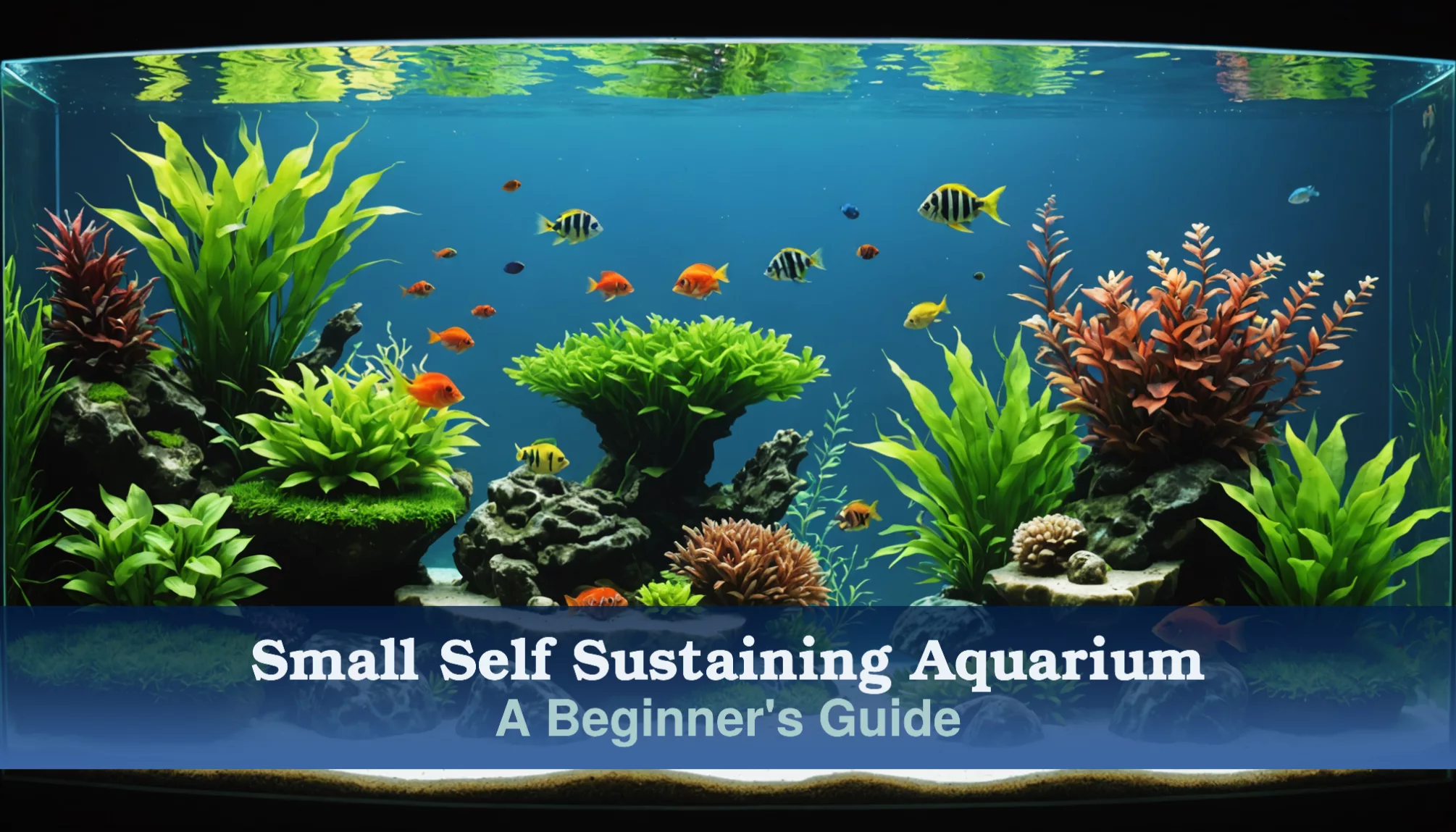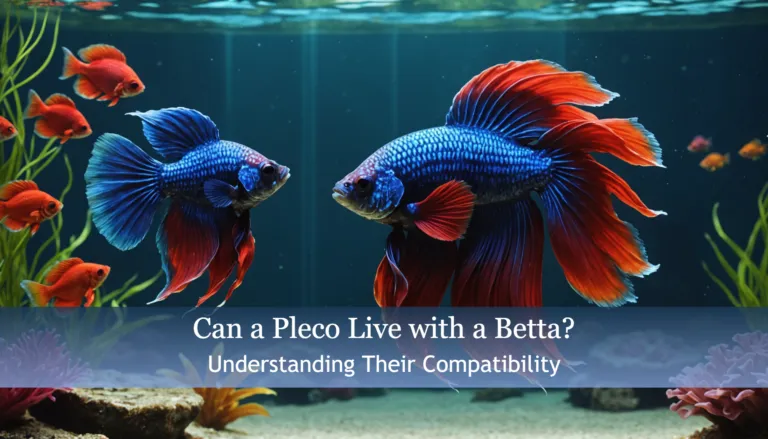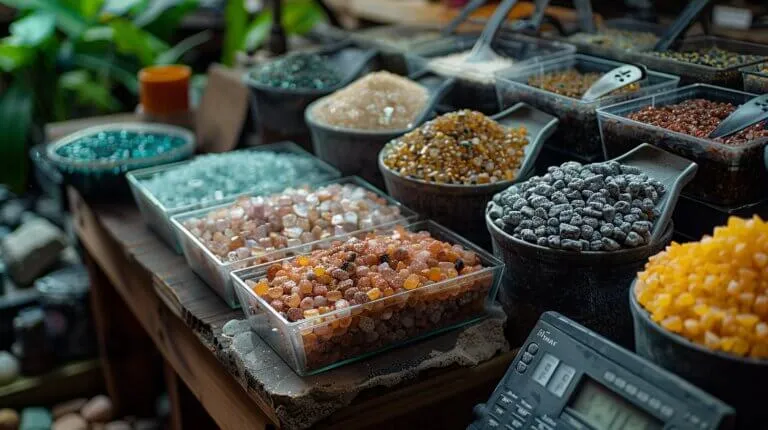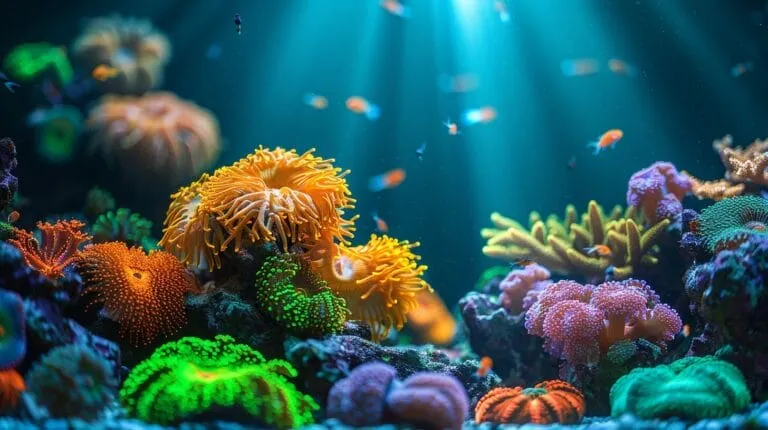Imagine having a magical underwater world right in your room that needs little to no maintenance! A Small Self Sustaining Aquarium is exactly that—a tiny ecosystem that thrives on its own. This unique setup not only showcases the stunning beauty of fish and plants but also teaches you about the wonders of nature and balance.
In this article, we’ll explore the basics of a self-sustaining aquarium, from choosing the right tank and fish to understanding how to keep it balanced and thriving. Get ready to dive into the world of aquatics and discover how to create your very own miniature paradise!
Understanding the Basics of a Self-Sustaining Aquarium

What Makes an Aquarium Self-Sustaining?
A self-sustaining aquarium can maintain its balance with little help from the owner. This balance occurs through a natural cycle. In this cycle, plants generate oxygen, fish produce waste, and beneficial bacteria break down that waste into nutrients for the plants. This process helps keep water quality high and creates a healthy ecosystem where both plants and fish can thrive. (EcoSphere)
Key Components: Substrate, Lighting, and Ecosystem
To build a successful self-sustaining aquarium, three key components are essential:
- Substrate: This is the material at the bottom of the tank, which can be sand, gravel, or soil. It provides vital nutrients for plants and a home for beneficial bacteria.
- Lighting: Proper lighting is crucial for photosynthesis. This process allows plants to convert light into energy, supporting their growth and helping to oxygenate the water.
- Ecosystem: A self-sustaining aquarium includes plants, fish, and microorganisms. These creatures interact with each other, creating a balanced environment that supports life. (Buceplant)
Advantages of a Self-Sustaining Fish Tank for Hobbyists
Self-sustaining aquariums offer several benefits for hobbyists:
- Low Maintenance: Once established, these tanks need less frequent water changes and upkeep, making them ideal for busy individuals.
- Educational: They provide a practical way to learn about ecosystems. Hobbyists can observe the interactions between plants and fish, helping them understand ecological principles.
- Aesthetic Appeal: A well-designed self-sustaining aquarium can be a beautiful focal point in any room. The lively plants and fish create a calming atmosphere.
By grasping these basics, hobbyists can create and enjoy a thriving self-sustaining aquarium that requires minimal effort while providing a rich learning experience and visual enjoyment.
Planning Your Small Self Sustaining Aquarium

Choosing the Right Tank and Location
Selecting the right tank is essential for a thriving self-sustaining aquarium. For beginners, a 5 to 10-gallon tank is ideal. This size allows enough room for aquatic life while remaining manageable. Place the tank in an area with indirect sunlight to avoid excessive algae growth. Direct sunlight can disrupt the ecosystem balance. Additionally, ensure the tank sits on a stable surface to prevent spills.
Key Considerations:
- Size: A 5 to 10-gallon tank is best for beginners.
- Location: Select a spot with indirect sunlight to reduce algae blooms.
- Stability: Place the tank on a stable surface to prevent accidents.
Essential Equipment and Technology for Sustainability
Maintaining a healthy environment requires specific equipment. Essential items include a filter, heater (if necessary), and lighting. A high-quality filter keeps the water clean, which is vital for the health of both fish and plants. If the fish need warmer water, a heater is necessary. Lighting is crucial as well; plants require 4-6 hours of light daily for effective photosynthesis.
Essential Equipment:
- Filter: Ensures clean water and maintains quality.
- Heater: Required for tropical fish; check each fish’s needs.
- Lighting: Supplies the necessary light for plant growth.
Selecting Livestock: Fish and Plants That Thrive Together
Choosing compatible fish and plants is critical for a balanced ecosystem. For small self-sustaining aquariums, Java moss and Anubias are excellent plant choices. These hardy plants enhance water quality. For fish, guppies and neon tetras are suitable options. They are small, colorful, and generally peaceful, making them great for community tanks. Select species that can coexist without aggression.
Recommended Livestock:
- Plants: Java moss, Anubias.
- Fish: Guppies, neon tetras.
Setting Up Your Tank: A Step-by-Step Guide
Setting up an aquarium is a straightforward process. Follow this step-by-step guide:
- Rinse the Tank and Substrate: Start by rinsing the tank and the substrate (gravel or sand) to remove dust and debris.
- Add Substrate and Decorations: Layer the substrate at the bottom and add decorations or rocks for hiding spots.
- Fill the Tank with Water: Slowly fill the tank with water, being careful not to disturb the substrate.
- Treat the Water: Use a dechlorinator to make the water safe for fish.
- Plant Aquatic Plants: Insert the plants into the substrate, ensuring their roots are well buried.
- Cycle the Tank: Allow the tank to cycle for a few weeks before adding fish. This process encourages beneficial bacteria to grow, converting harmful ammonia from fish waste into less harmful nitrites and then nitrates.
This setup lays the foundation for a successful self-sustaining aquarium.
Best Plants and Fish for a Self-Sustaining Ecosystem

Creating a self-sustaining aquarium means choosing the right plants and fish that work together to maintain a balanced ecosystem. This section explores the best plants and fish for your aquarium and highlights the important role of algae.
Top Aquarium Plants That Enhance Self-Sustainability
Plants are essential in a self-sustaining aquarium. They produce oxygen and absorb nutrients from fish waste. Here are some top plants that thrive in small self-sustaining aquariums:
- Java Fern: This hardy plant grows well in low light and does not need substrate to root, making it easy to care for.
- Anubias: Anubias is a low-light plant that attaches easily to rocks or driftwood. It grows slowly and helps improve water quality.
- Hornwort: This floating plant grows quickly, absorbs excess nutrients, and provides hiding spots for fish.
These plants beautify the aquarium while supporting a healthy environment for fish. They help oxygenate the water and manage algae levels.
Ideal Fish Species for Small Self-Sustaining Tanks
Choosing the right fish is crucial for a self-sustaining aquarium. Here are some fish species that adapt well to smaller tanks:
- Betta Fish: Betta fish are colorful, hardy, and thrive in smaller tanks. They require minimal care.
- Guppies: Guppies are lively and easy to care for. They reproduce quickly, so starting with a few can lead to a vibrant community.
- Neon Tetras: These small, colorful fish prefer to live in schools. They thrive in peaceful environments and create a lively atmosphere in the tank.
These fish are compatible with plants and help maintain the aquarium’s ecological balance. Choosing the right species ensures a harmonious and vibrant tank.
The Role of Algae in a Balanced Aquarium Ecosystem
Algae often gets a bad reputation, but it plays a vital role in a self-sustaining aquarium. Here’s how algae contribute to the ecosystem:
- Nutrient Absorption: Algae consume excess nutrients in the water, preventing nutrient overload that can lead to harmful algae blooms.
- Food Source: Some fish and invertebrates feed on algae, providing a natural food source and reducing the need for additional feeding.
- Indicator of Imbalance: While some algae are beneficial, excessive growth can signal an imbalance in the ecosystem. Monitoring algae levels is crucial for maintaining a healthy tank.
Maintaining a balance of algae is essential for the aquarium’s health. Regular monitoring can ensure that algae contribute positively to the ecosystem.
Maintenance and Care Tips for Your Self-Sustaining Aquarium

Maintaining a small self-sustaining aquarium is a rewarding project. This section offers practical tips on monitoring nutrient levels, keeping the water clear, and ensuring long-term sustainability.
Monitoring Nutrient Levels and Algae Growth
To keep a small self-sustaining aquarium healthy, regularly check nutrient levels. Key nutrients include nitrogen and phosphorus, which come from fish waste and uneaten food. High levels can cause algae blooms, where algae grow excessively. This can harm fish and plants, making monitoring essential.
Use a water testing kit to check levels of ammonia, nitrites, and nitrates. High ammonia levels can be dangerous for fish. Keep ammonia levels low to ensure the health of fish. If tests show high levels, perform a water change to reduce them.
How to Keep Your Aquarium’s Water Clear and Healthy
Clear water is vital for the health of fish and plants. Follow these steps to maintain clear water:
- Perform Bi-Weekly Water Changes: Change 10-15% of the water every two weeks to remove waste and excess nutrients. This keeps the water fresh.
- Trim Overgrown Plants: Plants can grow quickly. Trim overgrown plants to allow smaller plants to receive enough light.
- Ensure Proper Filtration: A suitable filter keeps water clean by removing debris and excess food. Ensure the filter matches the size of your aquarium.
By following these steps, the water will remain clear and healthy, reducing algae growth and providing a better environment for fish.
Long-Term Sustainability: Ensuring Your Tank Remains Balanced
A self-sustaining aquarium needs balance among fish, plants, and water conditions. To ensure long-term sustainability, consider these points:
- Choose Compatible Fish and Plants: Select fish and plants that thrive together. Hardy fish, like bettas and guppies, do well in self-sustaining environments. Plants such as Java fern and Ludwigia are great choices because they provide oxygen and food for fish.
- Monitor Ecosystem Health: Regularly observe fish behavior and plant growth. Healthy fish swim actively. If they seem lethargic or hide frequently, it may indicate water quality issues.
- Adapt to Changes: The aquarium environment can change. Adjust fish and plant quantities as needed to maintain balance. Start with a few fish and gradually increase their number to avoid overwhelming the system.
Focusing on these elements allows for a thriving self-sustaining aquarium that requires minimal maintenance.
Expert Tips from Professional Aquarists
Professional aquarists offer key strategies for creating and maintaining a successful self-sustaining aquarium. Here are some valuable tips:
- Start Simple: Beginners should consider a small fish tank of 5 to 10 gallons. Smaller tanks are easier to manage and balance ecosystem dynamics effectively.
- Choose Compatible Species: Selecting the right fish and plants is essential. Peaceful fish like bettas and guppies pair well with plants such as Java moss and duckweed. Match species that thrive in similar water conditions.
- Monitor Water Quality Regularly: Regular checks of water parameters, including nitrate and phosphate levels, help maintain a healthy balance. Automated testing kits can simplify this process.
- Incorporate Snails and Shrimp: Adding algae-eating animals like snails or shrimp enhances the ecosystem. They help manage algae levels and contribute to a balanced environment.
- Limit Feeding: Overfeeding fish causes excess waste and poor water quality. Providing a few bits of fish food every couple of days is usually sufficient.
- Utilize Natural Light: If possible, position the aquarium where it can receive natural light. This promotes plant growth without needing constant artificial lighting.
These tips from professionals, combined with the real-life experiences of hobbyists, provide a comprehensive approach to establishing a thriving self-sustaining aquarium.
Advanced Concepts and Techniques

Enhancing Your Aquarium with Additional Ecosystem Elements
Adding extra elements to a small self-sustaining aquarium can boost both its function and beauty. One of the best additions is snails or shrimp. These creatures help clean the tank by eating algae and leftover food. For example, snails remove excess algae, which keeps the aquarium clean and prevents algae blooms. Shrimp also contribute by consuming uneaten fish food and other waste, helping to maintain the ecosystem.
Live plants are another effective addition. Plants like Java moss and duckweed not only look great but also produce oxygen and absorb nutrients. They support a balanced environment by taking in waste from fish and turning it into nutrients that plants can use. This creates a thriving ecosystem where fish and plants coexist harmoniously.
Using advanced macro algae offers additional benefits. These algae absorb excess nutrients from the water, which helps keep it clean and reduces the need for frequent water changes. They also serve as natural filters and create habitats for small aquatic life, promoting biodiversity within the aquarium.
The Future of Self-Sustaining Aquariums: Innovations and Trends
The outlook for self-sustaining aquariums is exciting, thanks to new technologies. LED lighting has become popular due to its energy efficiency and its ability to enhance plant growth. These lights can mimic natural light cycles, which is crucial for plant health in the aquarium.
Automated monitoring systems are also emerging. These systems track water quality, temperature, and nutrient levels continuously. For example, devices that monitor ammonia and nitrate levels ensure that the water remains safe for fish. This technology allows aquarium owners to maintain optimal conditions without constant manual checks, making maintenance easier.
Eco-friendly materials are also being integrated into aquarium setups. Sustainable options for substrates and decorations lower environmental impact while enhancing the aquarium’s appearance. These innovations promote a responsible approach to aquarium keeping and align with self-sustainability principles.
Troubleshooting Common Challenges in Self-Sustaining Aquariums
Maintaining a self-sustaining aquarium can present challenges. Algae blooms are a common issue caused by high nutrient levels. Regularly checking nutrient levels and maintaining a balanced ecosystem with the right mix of plants and fish is essential. Introducing algae eaters, such as specific fish or snails, can help control algae growth.
Fish health is another concern. Observing fish behavior helps detect illnesses early. Signs such as unusual swimming patterns or lack of appetite may indicate health issues. Keeping water clean through effective filtration and monitoring ammonia and nitrite levels can prevent disease.
Cloudy water can also be a problem. This often results from excess nutrients or bacterial blooms. Ensuring the proper balance of fish and plants and using an effective filter can help keep the water clear. Regular water testing and adjustments are vital for maintaining a healthy aquarium.
Creating a successful small self-sustaining aquarium requires ongoing attention to balance and innovation. By adding ecosystem elements, utilizing new technologies, and addressing challenges, aquarium enthusiasts can cultivate a vibrant aquatic environment.
Conclusion
Creating a small self-sustaining aquarium is an exciting journey! By understanding the key components like substrate and lighting, you can build a thriving ecosystem with fish and plants that work together beautifully. Planning your tank and choosing the right livestock, such as hardy fish and beneficial plants, is essential for a balanced environment. Plus, with proper maintenance, like monitoring nutrient levels, your aquarium can remain low-maintenance and vibrant.
Now that you have the tools to start your own self-sustaining fish tank, let your creativity swim free! Dive deeper into the amazing world of aquatic life and explore even more about how to enhance your aquarium. Happy fish-keeping!
FAQs
1. What is the best size for a self-sustaining aquarium?
A tank of at least 10 gallons is best for a stable ecosystem. This size helps balance plants and fish, which is essential for maintaining water quality and keeping the aquarium’s inhabitants healthy.
2. Can tap water be used in my aquarium?
Yes, tap water can be used, but it needs treatment first. Many tap waters contain chlorine and other harmful chemicals. A water conditioner can remove these substances to ensure a safe environment for fish and plants.
3. How often should the aquarium be cleaned?
Regular maintenance checks are important. Heavy cleaning should be avoided to preserve beneficial bacteria that help break down waste. A light cleaning every few weeks is usually sufficient.
4. What types of fish are best for a self-sustaining aquarium?
Small fish like Betta fish and Neon Tetras are excellent choices. They thrive in smaller spaces and are generally peaceful, making them ideal for a community aquarium.
5. How can algae growth be controlled in my aquarium?
Maintaining a balance of light, nutrients, and plant life is key. Reducing light exposure and limiting fish food can help manage algae levels. Additionally, introducing algae-eating animals, such as snails or specific fish, can assist in controlling algae.




